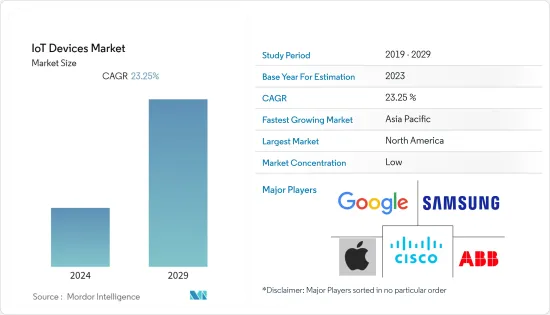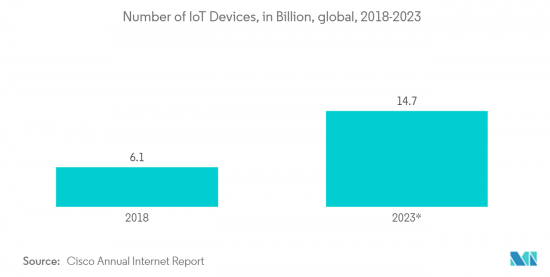 |
市場調査レポート
商品コード
1406888
IoTデバイス:市場シェア分析、産業動向・統計、2024~2029年成長予測IoT Devices - Market Share Analysis, Industry Trends & Statistics, Growth Forecasts 2024 - 2029 |
||||||
● お客様のご希望に応じて、既存データの加工や未掲載情報(例:国別セグメント)の追加などの対応が可能です。 詳細はお問い合わせください。
| IoTデバイス:市場シェア分析、産業動向・統計、2024~2029年成長予測 |
|
出版日: 2024年01月04日
発行: Mordor Intelligence
ページ情報: 英文 145 Pages
納期: 2~3営業日
|
- 全表示
- 概要
- 目次
今年のIoTデバイス市場は980億6,000万米ドルと推定されました。
同市場のCAGRは23.25%で、5年後には3,366億4,000万米ドルに達すると予想されています。IoT技術は、さまざまな企業がデジタルトランスフォーメーションを遂げるための基盤であり、新たなビジネスモデルを開発・監視することで現在の業務を改善することを可能にします。IoTは、企業やサービスプロバイダーがデジタルトランスフォーメーションを促進し、業務効率を明らかにするための主要なイネーブラーとみなされています。

主なハイライト
- IoTデバイスは、データ伝送速度によってより多くの恩恵を受ける可能性があります。IoTの導入と発展は、動向として5Gに依存しています。この技術により、最大10Gbpsの予測速度が可能になります。IoTネットワークの分析その他の機能は、データ交換のスピードとアクセシビリティとともに進歩します。5Gは、低遅延率と大容量化により、IoT機器の動作と通信方法に革命をもたらすと思われます。
- さまざまな分野でコネクテッド・デバイスを採用する傾向が強まっていることは、調査対象の市場にプラスの影響を与えます。エリクソンによると、大規模なIoT接続数は倍増し、2億近くに達する見込みです。エリクソンによると、2027年末までに、セルラーIoT接続の40%はブロードバンドIoTになる可能性が高く、4Gがそのほとんどを接続します。しかし、新旧の周波数帯に5G新無線(NR)がイントロダクションされれば、このセグメントのスループット・データ・レートは大幅に向上すると予想されます。
- モノのインターネット(IoT)は、適切なデータ共有ネットワークを確立するために、信頼性の高い接続性と通信を必要とします。消費者の需要により、通信事業者や開発者は接続技術を幅広く選択できるようになっています。
- RFIDやGSMのような無線通信技術や、一般的に機械間通信(M2M)の成功には、オープンスタンダードが不可欠です。世界的に認知された標準規格がなければ、RFIDやM2Mソリューションのモノのインターネット(IoT)への拡大は世界的規模に達することはできないです。相互運用可能な標準の迅速な設定の必要性は、IoTアプリケーションの展開に不可欠な要素として認識されています。IoTデバイスの導入が大きく普及しなければ、IoTデバイスの利用に支障をきたす可能性があります。
- IoTは、COVID-19パンデミック時の患者の健康状態のモニタリングに大きく活用されています。例えば2020年4月、SPHCCはBluetooth IoT製品およびソリューションプロバイダーであるCassia NetworkのゲートウェイとVivaLNKの医療用ウェアラブルセンサーをCOVID-19患者のモニタリングに使用していると発表しました。Cassiaのネットワーク管理ツールであるIoT Access Controllerは、医療スタッフが患者をモニターし、バイタルをよりリアルタイムに把握するために使用されます。Cassiaのゲートウェイは、SPHCCの複数の部屋をカバーするのに必要な長距離接続を実現しながら、ほぼ40台のBluetooth low energyデバイスを同時にペアリングして接続することを可能にします。
IoTデバイス市場動向
医療IoTアプリケーションが大きな市場シェアを占める見込み
- コネクテッド医療機器市場は、IoT技術に依存していることから、過去10年間一貫して成長してきた新しい医療産業の1つです。この特徴により、インダストリー4.0のパラダイムに近づいています。コネクテッド医療機器の世界では、製造・保守から使用まで、機器のライフサイクル全体を通じて技術統合の機会が存在します。20年以上もの間、消費者向けのヘルスケアは、業界を破壊してきたイノベーションの波に断固として抵抗してきました。人工知能(AI)や機械学習(ML)のようなテクノロジーは、コネクテッド・ヘルスケアの可能性をさらに広げるために不可欠です。
- 米国疾病予防センターの報告によると、出生時の平均余命は着実に伸びており、2017年の73.3歳から2022年には74.4歳を目標としています。この増加のほとんどは、乳幼児死亡率の低下によるものです。同調査によると、米国の平均寿命は78.6歳と3年連続で減少しています。人々は健康を維持し、食習慣を監視するために健康的なライフスタイルを目指して努力しています。このような人々の行動の変化は、コネクテッド医療機器の需要を増加させると思われます。
- さらに、不活発なライフスタイル、不健康な食生活、肥満のために、一部の新興国や先進国では糖尿病患者が増加しており、市場のプレーヤーにスマートなウェアラブル医療機器の開発を促しています。ベータ・バイオニクス社は、1型糖尿病の血糖値を24時間365日自律的に管理できる完全統合型医療用ウェアラブル・デバイスを開発しました。現在、臨床試験中であり、販売には至っていないです。
- IoMTアプリケーションの例としては、不規則な心拍や低すぎる心拍数を検出する心電図モニターや、スマートインスリンペンやグルコースメーターなどの糖尿病デバイスがあります。
- スマート・デバイスの採用の増加、医療分野におけるデータ分析需要の高まり、スマート・デバイスの手頃な価格での入手可能性、スマート・コネクテッド・デバイスやウェアラブルの市場浸透といった要因が、医療用IoTデバイスの市場成長に拍車をかけています。シスコのアニュアル・インターネット・レポートによると、今年末までにネットワークに接続されたデバイスと接続数は、2018年の184億から300億近くに増加します。2023年までに、IoTデバイスはネットワーク接続デバイス全体の50%(147億)を占めるようになり、2018年の33%(61億)から増加します。
- 反面、IoTデバイスの導入にはコストがかかる、IoTデバイスの導入による医療機関のセキュリティへの懸念などの要因が、医療用IoTデバイスの成長を妨げています。

アジア太平洋地域が大きな市場シェアを占める見込み
- アジア太平洋地域は、ALやIoTのような技術的進歩をいち早く取り入れてきました。これらの発展途上国諸国では、レガシーオートメーションシステムの再構築や機械への投資に苛まれることがないため、市場は産業オートメーションの導入において重要な利点をもたらします。
- 広く採用されるための重要な要因としては、この地域の様々な国の政府によって推進されているスマート国家構想や、製造業と物流部門における現在のインダストリー4.0推進が挙げられます。また、高ファイバー接続、データセンター、海底ケーブル、低電力ネットワークや5Gネットワークへの通信事業者の投資など、有利なインフラがIoTの採用をさらに促進すると思われます。
- 製造業はアジア太平洋地域の重要な産業です。その重要な一翼を担う中国経済は、人件費の高騰や従来の出稼ぎ労働者モデルが持続可能性を失ったことで、急速な変革期を迎えています。こうした動向は、製造工程の一部に自動化を導入するよう中国経済を後押ししています。
- IoTは、開発、生産、ロジスティクス・チェーン全体(スマート・ファクトリー・オートメーションとして知られる)の新しい技術的アプローチの中心であり、この地域における産業オートメーションの採用をさらに後押ししています。
- さらに、自動化プロセスの通信サポートにより、製造業者の採用が容易になりました。センサ・コンポーネント、より高速なネットワーク、高品質の診断ソフトウェア、高レベルの信頼性と安全な階層アクセスを備えた柔軟なインターフェース、エラー修正オプションが、この地域の生産性を高め、高品質の納品を継続し、製造コストを最小限に抑えています。
IoTデバイス産業の概要
IoTデバイス市場は非常に細分化されています。著名なプレーヤーには、アップル社、グーグル社(アルファベット)、サムスン電子(Samsung Electronics Co.Ltd.)などです。同市場のプレーヤーは、製品提供を強化し、持続可能な競争優位性を獲得するために、提携、合弁事業、買収などの戦略を採用しています。
2022年11月、サムスン・インドはモノのインターネット(IoT)対応の新しい空気清浄機を発表しました。新しい空気清浄機ラインにはAX46とAX32の2機種があり、ボタン1つで操作でき、ナノサイズの粒子、超微細なほこり、細菌、アレルギーを99.97%除去することを保証しています。また、ホルムアルデヒドなどの潜在的に有害な揮発性有機化合物(VOC)を簡単に除去し、顧客がきれいな空気を吸えるようにするとしています。さらに、サムスンは2022年8月にSmartThings Home Lifeを発表し、更新されたファミリーハブは、世界中の顧客を、ホームライフ体験を拡大するスマートな生活ソリューションのエコシステムに結びつける。
2022年9月、ハネウェルと、サウジアラビアの公共投資基金(PIF)とSTCグループ(STC)の合弁会社であるモノのインターネット技術会社(IoT-squared)は、サウジアラビアのデジタル化を推進する物流プラットフォーム、持続可能な都市、技術の分野を推進するための覚書(MoU)を締結しました。この戦略的MoUは、サウジ・ビジョン2030で策定されたスマートシティ開発と社会における技術導入拡大の目標を支援するものです。
その他の特典
- エクセル形式の市場予測(ME)シート
- 3ヶ月間のアナリスト・サポート
目次
第1章 イントロダクション
- 調査の前提条件と市場定義
- 調査範囲
第2章 調査手法
第3章 エグゼクティブサマリー
第4章 市場洞察
- 市場概要
- 業界の魅力度-ポーターのファイブフォース分析
- 供給企業の交渉力
- 買い手の交渉力
- 新規参入業者の脅威
- 代替品の脅威
- 競争企業間の敵対関係
- 業界利害関係者分析
- IoTライフサイクル分析
第5章 市場力学
- 市場促進要因
- 主要セグメントにおけるコネクテッド/スマートIoTデバイス需要の着実な成長
- ソフトウェア革新とコネクティビティ技術の向上が市場成長を牽引(買い替えサイクルの短縮による)
- 市場抑制要因
- 異なるプラットフォーム間での通信プロトコルの標準化の欠如
- IoT機器の普及を妨げるデータのセキュリティとプライバシーに関する問題
- 業界規制-ISO/IEC JTC、ETSI、ITUなど
- 価格分析
第6章 技術スナップショット
- IoTの進化
- 普及を後押しすると期待される主な破壊的技術の分析
- 主要IoTコンポーネントの分析
第7章 市場セグメンテーション
- アプリケーションタイプ別
- コネクテッド&スマートホーム
- 医療IoT
- コネクテッドカー
- スマートシティ
- 産業用IoT
- パーソナルIoT
- その他のアプリケーションタイプ
- 接続タイプ別
- WPAN
- WLAN
- LPWA
- セルラー/M2M
- その他の接続タイプ
- 地域別
- 北米
- 欧州
- アジア太平洋
- ラテンアメリカ
- 中東・アフリカ
第8章 競合情勢
- 企業プロファイル
- Apple Inc.
- ABB Limited
- Cisco Systems Inc
- Google Inc.(Alphabet)
- Samsung Electronics Co. Limited
- LG Electronics
- Siemens AG
- Honeywell International Inc.
- Sony Corporation
- Amazon.com, Inc.
- Robert Bosch GMBH
第9章 投資分析
第10章 市場の将来

The IoT devices market was estimated at USD 98.06 billion in the current year. The market is expected to register a CAGR of 23.25%, reaching USD 336.64 billion in five years. IoT technology is the foundation for different enterprises to undergo a digital transformation, enabling them to improve current operations by developing and monitoring new business models. IoT has been viewed as the primary enabler in boosting digital transformation and uncovering operational efficiencies by businesses and service providers.
Key Highlights
- IoT devices might benefit more from data transmission speeds. IoT adoption and development are reliant on 5G as a trend. Predictive speeds of up to 10Gbps are possible with this technology. IoT networks' analysis and other capabilities will advance, along with the speed and accessibility of data exchange. 5G will revolutionize how IoT equipment operates and communicates with lower latency rates and more capacity.
- The growing trend of adopting connected devices in various sectors positively influences the market studied. According to Ericsson, the number of massive IoT connections is expected to have doubled, reaching nearly 200 million. According to Ericsson, by the end of 2027, 40% of cellular IoT connections will likely be broadband IoT, with 4G connecting most of them. However, with the introduction of 5G New Radio (NR) in the old and new spectrum, throughput data rates are expected to increase substantially for this segment.
- The Internet of Things (IoT) requires dependable connectivity and communications to establish proper data-sharing networks. Due to consumer demand, operators and developers have a wide selection of connectivity technologies.
- Open standards are critical enablers for the success of wireless communication technologies, such as RFID or GSM, and, in general, for any machine-to-machine communication (M2M). Without globally recognized standards, the expansion of RFID and M2M solutions to the Internet of Things (IoT) cannot reach a global scale. The need for faster setting of interoperable standards has been recognized as an essential factor for deploying IoT applications. It may hinder the usage of IoT devices if the implementation does not gain significant traction.
- IoT is significantly being utilized for monitoring patients' health status during the COVID-19 pandemic. For instance, in April 2020, SPHCC announced that it is using Bluetooth IoT products and solutions provider Cassia Network's gateways and VivaLNK's medical wearable sensors to monitor COVID-19 patients. Cassia's IoT Access Controller, a network management tool, is used by medical staff to monitor patients and provide a better real-time view of their vitals. Cassia's gateways allow almost 40 Bluetooth low-energy devices to be paired and connected simultaneously while giving the long-range connectivity required to cover several rooms in the SPHCC.
IoT Devices Market Trends
Medical IoT Application Segment is Expected to Hold Significant Market Share
- The market for connected medical devices is one of those new medical industries that has consistently grown over the last decade, given its dependency on IoT technologies. This feature brings it closer to Industry 4.0 paradigms. In the world of connected medical devices, opportunities for technological integration exist throughout the device's lifecycle, from manufacturing and maintenance to use. For over two decades, consumer-facing healthcare has steadfastly resisted the wave of innovations that have been disrupting industries. This means that the industry is ripe for disruption, and technologies like Artificial Intelligence (AI) and Machine Learning (ML) will be vital to unlocking greater connected healthcare possibilities.
- According to the US Centers for Disease and Prevention report, the overall life expectancy at birth is steadily increasing, with a target of 74.4 years by 2022, up from 73.3 years in 2017. Most of the increase is due to lower infant mortality. According to the same survey, life expectancy in the United States has dropped for the third year in a row to 78.6 years. People strive toward a healthy lifestyle to keep fit and monitor their eating habits. Such changes in people's behavior will increase the demand for connected medical devices.
- Moreover, due to inactive lifestyles, unhealthy diets, and obesity, some emerging and developed regions are witnessing a rising number of diabetic patients, encouraging market players to develop smart wearable medical devices. Beta Bionics developed a fully integrated medical wearable device that can autonomously manage blood sugar levels 24/7 for type 1 diabetes. Currently, it is in the state of clinical testing and unavailable for sale.
- Examples of IoMT applications include an electrocardiogram monitor that will detect irregular heartbeats or rates that are too low and diabetes devices such as smart insulin pens and glucose meters.
- Factors such as increased adoption of smart devices, rising demand for data analytics in the health sector, availability of smart devices at affordable pieces, and the market penetration of smart connected devices and wearables provide impetus to the market growth of Medical IoT devices. According to Cisco's Annual Internet Report, by the end of the current year, there will be close to 30 billion network-connected devices and connections, up from 18.4 billion in 2018. By 2023, IoT devices will make up 50% (14.7 billion) of all networked devices, up from 33% (6.1 billion) in 2018.
- On the flip side, factors such as the cost to implement IoT devices can be difficult, and health organizations' security concerns due to the implementation of IoT devices hinder the growth of medical IoT devices.

Asia Pacific is Expected to Hold Significant Market Share
- Asia Pacific has been an early adopter of technological advancements like AL and IoT. In these developing economies, the market poses a key advantage in implementing industrial automation since it is not tormented with rebuilding legacy automation systems and machine investments.
- Some critical factors for the widespread adoption include the Smart Nation initiatives driven by the governments of the various countries in the region and the current Industry 4.0 drive in the manufacturing and logistics sectors. Also, favorable infrastructures, such as high fiber connectivity, data centers, submarine cables, and operators' investments in low-power and 5G networks, are likely to drive the adoption of IoT further.
- Manufacturing serves as a significant industry in the Asia Pacific. As a significant contributor, the Chinese economy is undergoing a rapid transformation as labor costs have risen and the conventional model of migrant workers has lost sustainability. Such trends have pushed the economy to adopt automation as a part of manufacturing processes.
- IoT, being at the center of new technological approaches for development, production, and the entire logistics chain (otherwise known as smart factory automation), has further driven the adoption of industrial automation in the region.
- Moreover, the communications support for automated processes has facilitated easier adoption among manufacturers. Sensor components, faster networks, quality diagnostic software, and flexible interfaces with high levels of reliability and secured hierarchical access, along with error-correction options, have added productivity, continued quality deliveries, and minimized the cost of manufacturing in the region.
IoT Devices Industry Overview
The IoT devices market is highly fragmented. Some prominent players include Apple Inc., Google Inc. (Alphabet), and Samsung Electronics Co. Limited. Players in the market are adopting strategies such as partnerships, joint ventures, and acquisitions to enhance their product offerings and gain sustainable competitive advantage.
In November 2022, Samsung India unveiled its new Internet of Things (IoT)-enabled air purifiers. The new air purifier line contains two models, AX46 and AX32, with a one-button operation and guarantees to remove 99.97% of nano-sized particles, ultrafine dust, germs, and allergies. They also claim to easily remove potentially hazardous volatile organic compounds (VOCs), such as formaldehyde, ensuring that customers breathe clean air. Furthermore, Samsung announced SmartThings Home Life in August 2022, and the updated family hub links customers worldwide to an ecosystem of smarter living solutions that expand their home life experience.
In September 2022, Honeywell and Internet of Things Technologies Company (IoT-squared), a joint venture between Saudi Arabia's Public Investment Fund (PIF) and STC Group (STC), signed a Memorandum of Understanding (MoU) to advance the fields of logistics platforms, sustainable cities, and technologies which would drive the digitalization in Saudi Arabia. The strategic MoU supports the goals established in Saudi Vision 2030 for smart city development and expanding technology adoption in society.
Additional Benefits:
- The market estimate (ME) sheet in Excel format
- 3 months of analyst support
TABLE OF CONTENTS
1 INTRODUCTION
- 1.1 Study Assumptions and Market Definition
- 1.2 Scope of the Study
2 RESEARCH METHODOLOGY
3 EXECUTIVE SUMMARY
4 MARKET INSIGHTS
- 4.1 Market Overview
- 4.2 Industry Attractiveness - Porter's Five Forces Analysis
- 4.2.1 Bargaining Power of Suppliers
- 4.2.2 Bargaining Power of Buyers
- 4.2.3 Threat of New Entrants
- 4.2.4 Threat of Substitutes
- 4.2.5 Intensity of Competitive Rivalry
- 4.3 Industry Stakeholder Analysis
- 4.4 IoT Lifecycle Analysis
5 MARKET DYNAMICS
- 5.1 Market Drivers
- 5.1.1 Steady Growth in Demand for Connected/Smart IoT Devices in Key Segments
- 5.1.2 Software Innovations and Improvements in Connectivity Technologies to drive market growth (by Lowering Replacement Cycle)
- 5.2 Market Restraints
- 5.2.1 Lack of Standardization of Communication Protocol across Different Platforms
- 5.2.2 Issues Related to Security and Privacy of Data to Hinder the Adoption of IoT Devices
- 5.3 Industry Regulations - ISO/IEC JTC, ETSI, ITU, etc.
- 5.4 Pricing Analysis
6 TECHNOLOGY SNAPSHOT
- 6.1 Evolution of IoT
- 6.2 Analysis of Key Disruptive Technologies Expected to Aid Adoption
- 6.3 Analysis of Major IoT Components
7 MARKET SEGMENTATION
- 7.1 By Application Type
- 7.1.1 Connected and Smart Home
- 7.1.2 Medical IoT
- 7.1.3 Connected Car
- 7.1.4 Smart Cities
- 7.1.5 Industrial IoT
- 7.1.6 Personal IoT
- 7.1.7 Other Application Type
- 7.2 By Connectivity Type
- 7.2.1 WPAN
- 7.2.2 WLAN
- 7.2.3 LPWA
- 7.2.4 Cellular/M2M
- 7.2.5 Other Connectivity Type
- 7.3 By Geography
- 7.3.1 North America
- 7.3.2 Europe
- 7.3.3 Asia Pacific
- 7.3.4 Latin America
- 7.3.5 Middle East and Africa
8 COMPETITIVE LANDSCAPE
- 8.1 Company Profiles
- 8.1.1 Apple Inc.
- 8.1.2 ABB Limited
- 8.1.3 Cisco Systems Inc
- 8.1.4 Google Inc. (Alphabet)
- 8.1.5 Samsung Electronics Co. Limited
- 8.1.6 LG Electronics
- 8.1.7 Siemens AG
- 8.1.8 Honeywell International Inc.
- 8.1.9 Sony Corporation
- 8.1.10 Amazon.com, Inc.
- 8.1.11 Robert Bosch GMBH
